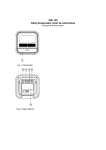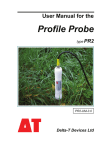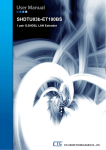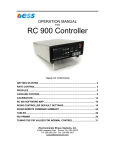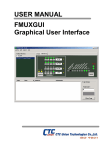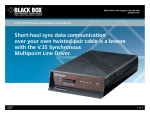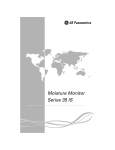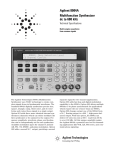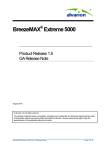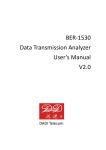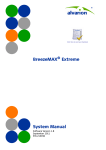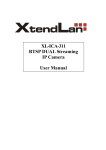Download FMUX Series User`s Manual for Multi
Transcript
FMUX Series User’s Manual for Multi-service Access Platform V2.01 Table of Contents 1 Overview............................................. 1 2 Features ............................................. 1 3 Technical Indicators .................................... 2 3.1 Environmental requirements .................................... 2 3.2 Power interface .............................................. 2 3.3 Power consumption........................................... 2 3.4 Optical interface ............................................. 2 3.4.1 Double fiber bidirectional operating mode ................... 2 3.4.2 Single-Fiber bidirectional operating mode ................... 3 3.5 E1 interface ................................................. 3 3.6 V.35 interface ............................................... 4 3.7 Data channel ................................................ 6 3.8 CONSOLE for management .................................... 6 3.9 Order wire .................................................. 7 3.10 Extended dimensions ........................................ 7 4 Typical application ..................................... 7 5 Installation And Device Instructions....................... 8 5.1 Unpacking.................................................. 8 5.2 Mechanical installation ........................................ 8 5.2.1 Tools and meters needed ................................. 8 5.2.2 Opening.............................................. 8 5.2.3 Equipment examination.................................. 9 5.2.4 Equipment installation................................... 9 5.2.5 Equipment testing ..................................... 10 5.3 Warning Direction and Interface ................................ 11 5.4 Test for Maintenance......................................... 13 6 Data Exchange Channel of E1/V.35....................... 15 7 Protection and Replacement Norm for Dual Optical Path .... 16 7.1 Replacement Mechanism ..................................... 16 7.2 Reset Mechanism ........................................... 16 7.3 Network Management Function ................................ 17 8 Solution to Common Malfunction ........................ 17 8.1 Optical Lost Warning ........................................ 17 8.2 E1 Warning ................................................ 17 8.3 Remote Interface Warning .................................... 17 8.4 The High Rate of Error Code .................................. 18 1 Overview FMUX series Optical modem is a series of optical and electrical transmission equipment manufactured by XtendLan. With the ASIC as its core, it supports multiple E1 and 1-2 n×64k V.35 channel, support dual optical port provide 1+1 service protection, very suitable for small-capacity switch networking, user loop network, mobile communications (base station), private network, DDN, etc. FMUX series comprises of 120 mixed optical and electric lines with VLSIC as its core. Its E1 and V35 channel provide integrated BERT(Bit Error Rate Test)for user testing and maintenance. In addition, FMUX series of optical modem can also provide rack mount for easy maintenance, plug and play, and provide complete network management. TYPE FMUX-4E1 FMUX-4E1-V1 FMUX-4E1-V2 K-FMUX-4E1 FMUX-4E1-D FMUX-4E1-V1D FMUX-4E1-V2D K-FMUX-4E1-D Optical 1 1 1 1 2 2 2 2 Basic service 4×E1 4×E1+1×V.35 4×E1+2×V.35 4×E1 4×E1 4×E+1×V.35 4×E1+2×V.35 4×E1 Dimension 19‖×1U 19‖×1U 19‖×1U Card 19‖×1U 19‖×1U 19‖×1U Card Protection 1+1 protection 1+1 protection 1+1 protection 1+1 protection 2 Features □ Provide 4 E1 digital ports, 75Ω~120Ω impedance options; □ E1 & V35 channel support BERT(Bit Error Rate Test) □ Provide an order line port; □ Provide a RS232 asynchronous data port; □ Provide a management port for centralized monitoring and supporting system upgrade; □ Provide a set of control switch for device testing and maintenance; □ Based on ASIC, simple circuit, low power consumption and high reliability; □ Being suitable for multiple power environment –48VDC or 220VAC; FMUX series User‘s Manual Page 1 □ Standard 1U rack with the characteristics of small size, light height, high reliability and easy for installation; □ FMUX-4E1-D, FMUX-4E1-V1/2-D provide dual optical port to reach 1+1 service protection; □ FMUX-4E1-V1/2(-D) provide 4*E1 and 1-2 n×64k V.35 channel; □ Support channel switch of E1 and V.35; □ V.35 support 7 clock mode (DCE: location, restoration, exterior input; DTE: send RC receive TC, send RC receive RC, send TC receive TC, send TC receive RC) is suitable for all V.35 requirement for port clock mode on the market at present; □ FMUX-4E1 and FMUX-4E1-D can provide centralized shelf cards structure. 3 Technical Indicators 3.1 Environmental requirements The device is designed for operating under extended range of temperatures, maintaining normal and stable operation in tough environment. □ Operating temperature: 0℃ to 50℃ □ Relative humidity: < 95% (condensation free) □ Atmospheric Pressure: 86~106Kpa 3.2 Power interface □ DC-48V model: Input voltage ranging between DC-36V~DC-72V □ AC 220V model: Input voltage range municipal AC130V~AC250V 3.3 Power consumption Overall power consumption <10W 3.4 Optical interface 3.4.1 Double fiber bidirectional operating mode □ Wavelength: While operating as double fiber bidirectional operating mode, there are 2 wavelength types of equipments Transmitting wavelength: 1310nm 1310nm (standard model) FMUX Series User‘s Manual Page 2 Receiving wavelength: Transmitting wavelength: 1550nm Receiving wavelength: 1550nm (customized model) □ Transmitting power: Better than: better than -13dBm □ Receiving sensitivity: Better than -34dBm(BER≤10-11) □ Interface mode: FC/SC □ Line coding:1B1H □ Line rate:16.896Mbit/s 3.4.2 Single-Fiber bidirectional operating mode □ Wavelength: While operating as double fiber bidirectional operating mode, there are 2 wavelength types of equipments Transmitting wavelength: 1310nm Receiving wavelength: 1550nm (standard model) Transmitting wavelength: 1550nm Receiving wavelength: 1310nm (customized model) □ Transmitting power: better than -16dBm □ Receiving sensitivity: better than -32dBm (BER≤10 ) □ Connector: SC □ Line rate:16.896Mbit/s Note: when optical disc is in the mode of single fiber bidirectional, each of equipment types must be selected to make a match. For example, if wavelength 1310nm is selected by office terminal, the remote terminal would have to select 1550nm single fiber type. Otherwise, optical terminal machine cannot operate normally. The reverse way is acceptable, too. 3.5 E1 interface 4 lines of E1 interface of the equipments conforms to G.703 suggestions. □ Rate: 2048Kbit/s, ±50ppm □ Code pattern: HDB3 □ Impedance: 75Ω(unbalanced),120Ω(balanced) □ Jitter characteristics: meeting the G.742, G.823 suggestions □ Admissible attenuation of input interface: 0~6dBm FMUX series User‘s Manual Page 3 □ E1 local Loopback: Per channel □ Remote Loopback: Per channel 3.6 V.35 interface □ Port rate: n×64K; □ Without traffic control, transparent transmission; □ Connector: DB25 slot; □ DCE or DTE optional; FMUX Series User‘s Manual Page 4 □ Definition of V.35 Port (DCE Mode: E1 Main Clock/E1 Subordinate Clock/V.35 Exterior Clock): Pin 1 2 3 M/34 A P R I/O I O Definition GND TDA RDA Function Signal GND Transmit data line A Receive data line A Transmit requestment 4 C I RTS 5 D O CTS Transmit permission 6 E O DSR Prepared data equipment 7 B 8 F O 9 X 10 GND Protection GND DCD Data carrier detect O RCPB Receive clock line B I Reserved 11 W I ETCB Exterior clock line B 12 AA O TCPB Transmit clock line B 14 S I TDB Transmit data line B 15 Y O TCPA Transmit clock line A 16 T O RDB Transmit data line B 17 V O RCPA Receive clock line A 13 NC 18 NC 19 20 NC H I 21 Data transport ready NC 22 NC 23 24 25 DTR U I Reserved I ETCA NC Exterior clock line A FMUX series User‘s Manual Page 5 □ Definition of V.35 Port(DTE Mode) Pin 1 2 3 F/34 A R P FMUX Series User‘s Manual Page 6 I/O I O Definition GND RDA Function Signal grand Receive data line A 3.9 Order wire □ Connector: RJ11 3.10 Extended dimensions Standard device :W×D×H=483mm×175mm×45mm 4 Typical application FMUX series Point-to-Point networking application 1 Note: FMUX Series can also cooperate with centralized office terminal type of equipments and compose star network. FMUX series User‘s Manual Page 7 5 Installation And Device Instructions 5.1 Unpacking FMUX Series multi-service private Line access platform, which is provided with some shockproof foam inside for protection, contains only one device for each. Please assure that the box is open with its obverse facing up. 5.2 Mechanical installation 5.2.1 Tools and meters needed □ Slotted screwdriver, cross screwdriver □ Gab tongs, slanting gab tongs □ Multimeter □ Electric iron □ Optical ergometer □ Optical Attenuator □ Transmitting measurement meter(Error Detector) Note: The meters underlined is optional 5.2.2 Opening 1. After making sure installing location of the optical modem and make clear of the place, you will transfer the box with optical modem to installing location; 2. Please pay attention to direction of box and make sure its front upward; 3. Opening up box, then taking out equipment and accessories. 4. Optical modem is packaged with special box with protection from shock. There are two sets in each package box, which include relative accessories. Please examine it and check whether or not it conforms to bill. (Optical modem with inner structure is characterized by precision. So pay close attention to gentle carry and take and avoid fiercely FMUX Series User‘s Manual Page 8 shock not to affect the function of optical modem. If you find out damaged and lost any parts for optical modem in the course of transportation, you should inform after-sales department in our company immediately. Then we will make a proper and sound solution as soon as we could.) 5.2.3 Equipment examination To check whether or not the optical modem is perfect and out of use and the condition of power. 5.2.4 Equipment installation 1. Taking out the equipment and checking outlook, then fixing on the frame or another equipment to ensure the sound installation; 2. Making choice of power (AC220VorDC-48) based upon the structure of equipment, which abides by the connection of line of power correctly. To test whether or not the power is well function through electricity. Indicator light is on (POWER, GREEN) with proper work; Whether or not working condition is well-function or System working dictator light flashes (RUN, GREEN); Without connecting fiber, optical module system working indicator light (WORK, GREEN) is off but optical synchronization loss indicator light (SYLOS, RED) is on; 3. Connecting with remote equipment linking to fiber, optical module indicator light under the proper working condition (WORK, GREEN) is on and optical synchronization loss indicator light (SYLOS, RED) is off; Provided in the case of working improperly, relative staff need to check whether or not light channel is working properly and fiber at the bottom have the sound function for sending and receiving and remote equipment is electrified; Connecting with fiber with dual optical channel and 1+1 working indicator light of optical channel (SAT ,YELLOW) under defaulting condition is off indicates working channel is 0 in optical channel; Being on , indicates working channel is 1 in optical channel and can make stimulating optical channel of optical FMUX series User‘s Manual Page 9 fiber observe optical protection switch and STA indicator light. 4. Connecting with signal E1 line, if users‘ equipment have worked properly, signal E1 (LLOS, RED) related to light is off. 5.2.5 Equipment testing 1. Power: To make sure to connect power line in connection, to switch on power switch. If the power indicator light (POWER, GREEN) is on, it shows power is working properly; 2. Equipment Operation: having been electrified, equipment enters into operation. When system working indicator light (RUN, GREEN) is flashing, it indicates proper operation for equipment; 3. Optical Interface: When equipment works properly, fiber at the bottom will put optical interface loopback and optical module working indicator light (WORK, GREEN) is on. If optical synchronization loss indicator light (SYLOS, RED) is off, it indicates the optical interface is perfect; 4. Optical Interface Switch: When equipment is working properly, optical path 1+1 working indicator light (STA, YELLOW) is off, which indicates that working channel is 0 in the optical channel (tacitly accepted working channel). If taking out link0 with fiber in optical interface, stimulating optical path will result in failure. Then optical path 1+1 working indictor light (SAT, YELLOW) is on, indicating the service have been switched to channel one. 5. E1/V.35 Interface: When equipment operates properly, technological staff will optical loop automatically and use error code instrument to test error code. If nothing, it is perfect; 6. RS232 Interface: When equipment operates properly, technological staff will loop optical interface automatically and connect RS232 interface with PC‘s series interface. ―Super Terminal‖ (baud rate is 9600bit/s) operates on PC, which prevents from re-showing option of local character. Then keying into testing character and displaying character FMUX Series User‘s Manual Page 10 that is received in windows. It is the same with inserted character to indicate that RS232 interface is working properly. 5.3 Warning Direction and Interface FMUX series provides integrated warning direction and condition direction. Red light shows serious warning and system cannot work properly; Yellow light shows the existence of warning and system works well basically; Green light shows system is working perfectly. Alarm light Definition Sound operation loopback RUN, Green Sound operation; under the condition of dipswitch, on (on 1/4 second + off 3/4 seconds, then cycle); under the condition of network management, off (on 3/4 seconds + 1/4 second, then cycle) STA, Yellow If under the model of dual optical interface, operation is off on the main optical interface meanwhile operation is on the spare optical interface; The model of single optical interface is off usually. SYLOS/1E-3, RED Optical interface data is off naturally. Optical synchronization loss or 10-3 error code is on. 1E-6, YELLOW Optical interface data is naturally.10-6 error code is on. WORK, GREEN Optical take-over power is on when performed well or it is off. RA, YELLOW If remote optical loss or synchronization loss, warning is on, remote call (press down the switch of CALL) is on. LLOS(1~4), RED Local interface related to E1 that has a connection is off. Without connection, it is on. RLOS(1~4), RED Remote interface related to E1 that has a connection is off. Without BERT If condition of non-synchronization flashes, condition of synchronization with non-error code is off and error code <10-3 on, error code>10-3 flashes, keeping the same step with the condition of the most serious error code. off When E1 has loopback Flash show it received testing code for local E1 port. Flash show the transmission of testing code FMUX series User‘s Manual Page 11 connection, it is on. for local E1 port. FSL, RED V.35is is working for the way of framed E1. And 2M data‘s frame synchronization loss. TD, GREEN When V.35 is sent (optical direction), its result comes out the changing flash. RD, GREEN After V.35 data is received from optical interface ,its result come out the changing flash. ULK, YELLOW The send of V35 and the set of clock model don‘t come out the signal. Flash Flash show the transmission of testing code for local port. Order wire (HANDSET) Interface: relative staff will insert special handset of orderwire into interface then and communicate through the orderwire; When staff press down the CALL button of local port , remote interface set will come out buzz ,which indicates the other side may communicate; Buzzing Warning: When optical loss-that is- optical synchronization loss indicator light (SYLOS, RED) is on, system provide serious warning and buzzer of equipment begins to sound; At this time staff press the button of CALL, which shut down the buzz.; If staff press the button of CALL again , the buzz will sound once again; Management Interface(CONSOLE): it connects with main computer, which result in the recognition of function of management; E1 interface locates the back side of equiment; Dip switch: 1 2 3 4 5 6 7 8 OFF ON Dip Switch1, 2: to maintain the option of testing mode (OFF=1, ON=0); 00=engineering BERT test; FMUX Series User‘s Manual Page 12 01=the loopback of remote equipment and to control remote equipment E1 interface to switch to loopback of counter-direction and the max time of loopback is limited to an hour; 10=company preservation; 11=normal model; Dip Switch 3, 4, 5, 6, 7, 8: to maintain option of test channel, corresponding to E1 interface 1, 2, 3, 4, V.35 interface 1, 2(OFF= normal , ON=maintain test model); Dip switch setting of ex-factory all are “OFF”. Having been finished maintaining and checking, staff should place dipswitch in the place of ex-factory. 5.4 Test for Maintenance FMUX series of optical modem support test for maintenance by network management or dipswitch with loopback, BERT and so on. Controlling Way of Maintaining Test Equipment with ex-factory is under the condition of default. Under the condition, switch of dip switch is available. The equipment is characterized by the choice of between ―maintain operation controlled by switch of dip switch‖ or ―maintain operation controlled by network management‖ and it possesses the function of protection when cut down electricity. ―Maintaining operation controlled by network management‖ must be settled in advanced to make test for maintenance through network management. To operate the clear out cut-off electricity is through maintenance to network setting. FMUX series User‘s Manual Page 13 BERT Test Principle The inner of equipment is laid simple error code instrument that may through dip switch or inner error code instrument to reach data channel of receive and send. Panel indicator light may direct the synchronous condition , the class of error code (non-error code , <10-3,>10-3). And network management may memory time of coming out error code and the number of error code. BERT need loopback of E1 interface, local E1 in series and other assisted way, etc. (Optical interface, exclusive chip) Measuring Method for BERT in Project Project detect is designed for transferring and receiving the data in regular condition. Take the first E1channel for example. The process of detect is as follow: To connect optical fiber rightly and ensure the proper operation of transmitting and receiving data in two-side equipment; To set remote equipment corresponding with E1 interface toward optical interface direction to loopback, the switch of dip switch move from to FMUX Series User‘s Manual Page 14 ; To make sure the start of loopback by indicator light—RLOS-1 in local interface is off; To set channel EERT of local interface E1, the switch of dip switch move from to . 6 Data Exchange Channel of E1/V.35 FMUX-4E1-V1, FMUX-4E1-V2, FMUX-4E1-V1-D, FMUX-4E1-V2-D support data channel optional exchange of E1/V.35 so that V.35 channel is easily corresponding to E1 channel of remote equipment. (Our company ‗s other 4E1, 8E1 optical transfer equipment); Network management may choose V.35 data, which take up original channel model or choose regular E1 channel model to reach data channel exchange of E1/V.35 FMUX-4E1-V1,FMUX-4E1-V1-D channel exchange(default <ex-factory>) CH1 E1 ch1 CH2 CH3 CH4 CH5 E1 ch2 E1 ch3 V35 E1 ch4 CH5 take up original channel CH1 E1 ch1 CH2 CH3 CH4 E1 ch2 E1 ch3 E1 ch4 FMUX-4E1-V2,FMUX-4E1-V2-D channel exchange(default<ex-factory>) CH1 E1 ch1 CH2 E1 ch2 CH3 V35 ch2 V35 CH4 CH5 V35 ch1 E1 ch4 CH6 E1 ch3 FMUX series User‘s Manual Page 15 take up original channel CH1 E1 ch1 CH2 CH3 CH4 CH5 E1 ch2 E1 ch3 E1 ch4 V35 ch1 CH6 V35 ch2 7 Protection and Replacement Norm for Dual Optical Path PDH optical transmission equipment with dual port can realize 1+1 service protection. Protection for operation mechanism is divided into two parts –replacement and reset. The former one is that working channel is switched to spare channel when working channel happens to malfunction; the latter one is that spare channel is switched to original working channel because of replacement and solution to malfunction of original working channel. 7.1 Replacement Mechanism Taking the mechanism of dual send and sound receive is that send port will be sent simultaneously in the same service in two optical fiber; Main channel based upon fixed (ex-factory---default is 0.) when send port is normal. When main channel happens to malfunction and spare channel is normal, the main channel within 50ms can switch to spare channel to receive data and give out warning for network management. Malfunction of Optical Channel Include: Optical signal disappear; Frame with malfunction loss; Channel error code surpass the limitation; 7.2 Reset Mechanism Network management can configure can decide whether or not to reset and reset wait time after reset. Main channel may be on-and-off phenomenon in the course of malfunction rewetted. Please refer to SDH technological standard. Resetting wait time is 5-12 minutes in usual condition. FMUX Series User‘s Manual Page 16 7.3 Network Management Function Network management may decide working channel and protection channel; Network management may compulsorily switch to certain channel; Network management may set after replacement whether or not to reset wait time; 8 Solution to Common Malfunction 8.1 Optical Lost Warning Optical synchronization loss indicator light (SYLOS, RED) is on to check connection optical fiber with optical modem, whether or not, is perfect; Whether or not optical fiber with receives and send is connected each other in the opposite direction; To check optical interface of equipment, whether or not, is well-function; To check whether or not optical link is good to test optical receive power. 8.2 E1 Warning LLOS is warning light for local port E1. RLOS is warning light for remote E1 port. When LLOS light is on, relative staff should check joining line of E1 local interface to connect availably or not, examine quality and extension of joining line and test operation of all users is well-function or not; When RLOS light is on, relative staff should check joining line of E1 remote interface to connect availably or not, examine quality and extension of joining line and test operation of all users is well-function or not; 8.3 Remote Interface Warning If remote interface does not call local interface, local interface RA light is on, FMUX series User‘s Manual Page 17 which indicates the remote interface optical receive signal or synchronization loss with the remote interface. Relative staff should check send optical signal with local interface and receive optical signal with remote interface and optical link. 8.4 The High Rate of Error Code To check interface impedance is set rightly or not. If interface impedance is right, relative staff examine segment by segment through error code instrument, taking removing way to check the cause of malfunction coming from local optical path or the equipment itself. FMUX Series User‘s Manual Page 18























